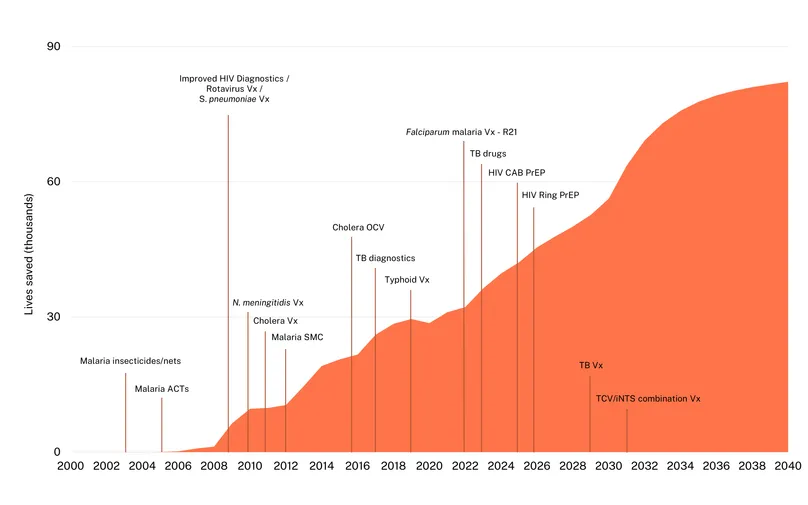Neglected disease R&D: A smart investment for a safer, stronger United Kingdom
By Dr Céline Aerts 25 April 2025
Investment in global health R&D generates high returns
Tight budgets often require tough choices but cutting overseas funding for global health R&D is a short-sighted decision. Although it only accounts for a small fraction of total spending, this investment generates disproportionately high returns: it not only improves health and strengthens economies in low- and middle-income countries, but also bolsters the UK’s scientific leadership, economic resilience, and global health security.
At a time when the world faces escalating threats—from antimicrobial resistance to climate-sensitive diseases—key funders such as the United States and several European nations are scaling back. The UK now finds itself at a critical juncture, with the opportunity to step forward as a leader, or risk stepping back just when global leadership is most urgently needed. In moments like these, the question isn’t how much we spend, but where we invest to secure the greatest long-term returns for both society and science. Our new report provides clear answers. Drawing on decades of data, it shows that the UK’s longstanding commitment to global health R&D not only saves lives but also drives scientific breakthroughs and generates tangible economic benefits.
By 2040, the £2.2 billion invested by the UK in neglected disease R&D—along with an additional £800 million needed to bring late-stage products to market—is projected to save 1.43 million lives, avert 99.1 million disability-adjusted life years (DALYs), and prevent 183 million neglected disease cases, generating a staggering societal return of £1.39 trillion.

But these returns are not guaranteed. If the UK—alongside other key global health R&D funders—continues to reduce its support, hard-won progress on life-saving innovations could rapidly unravel, putting millions of lives and decades of global health advancements at risk. Recent decisions by the UK government to cut official development assistance from 0.5% to 0.3% of national income can place this progress in jeopardy. The report warns that if late-stage products fail to reach the market, more than 113,000 preventable deaths could occur worldwide—and if the rollout of already-approved tools is disrupted, the toll could rise to as many as one million lives lost. And this represents only the UK’s share—the global impact would be far greater.
Behind each of these numbers is a person, a family, a community whose future depends on continued progress. Sustained investment in R&D is therefore crucial to ensure that scientific breakthroughs translate into real-world impact, alongside sufficient programmatic and health system investments to support the rollout of already-launched products.
Beyond health gains: Scientific and economic gains for the UK
Public investment in global health R&D doesn’t just save lives abroad—it delivers real dividends at home. It fuels growth in UK industries, drives innovation, creates high-quality jobs, and strengthens the scientific infrastructure that makes the UK globally competitive. With sustained investment, the UK’s contribution in neglected disease R&D will have generated £7.7 billion in additional domestic economic activity, catalysed over £4.43 billion in private-sector R&D investment, supported directly nearly 4,000 UK jobs, and contributed to 54 new patents and nearly 5,000 scientific publications.
These figures are just the quantifiable benefits and speak to the often-overlooked spillover effects of public investment in global health: investment focused on diseases in low- and middle-income countries can simultaneously enhance UK economy and research capacity, attract private investment, and cement the UK’s standing as a global leader in science and health security.
A foundation for future preparedness
As the report highlights, some of the most transformative health innovations in recent years were born from investments in neglected disease R&D. One striking example is the chimpanzee adenovirus platform that underpinned the Oxford/AstraZeneca COVID-19 vaccine—originally developed through UK-funded research on malaria and other infectious diseases.
This case demonstrates how investments in neglected disease R&D can lay the groundwork for broader breakthroughs, with far-reaching implications not only for global health systems but also for the UK’s emergency preparedness, scientific leadership, and economic resilience.
At a critical juncture
The UK’s contributions, while substantial, now hang in the balance. With the United States pulling back from global health commitments, Britain’s leadership is more important than ever. Yet UK funding has fallen sharply—from £207 million in 2018 to just £71 million in 2023. If this trend continues, the UK risks losing decades of hard-won progress and its standing as a global health leader. Every pound invested in global health R&D delivers returns far beyond its initial cost—saving lives, fuelling discoveries, and building the tools we need to fight the next health crisis. The opportunity is clear, and the time to act is now.

A stronger and safer United Kingdom through investment in global health R&D
New analysis of the impact of the UK's investment in neglected disease R&D

Foreword by Professor David Lalloo and Professor Liam Smeeth
David Lalloo and Liam Smeeth urge the UK government to sustain investment

Video of key messages
A short video highlighting the key messages from the UK report